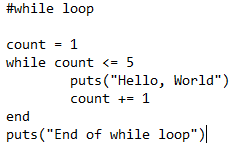Let s look at these in detail.
Ruby loops and iterators.
It uses method syntax.
Iterators return all the elements of a collection one after the other.
We will be discussing two iterators here each and collect.
A loop is the repetitive execution of a piece of code for a given amount of repetitions or until a certain condition is met.
Times step loops test and benchmark iterators.
If we discount the loop method then the for loop acts as a kind of bridge between looping constructs and iterators in ruby.
You can use the for loop to loop over values in a range e g.
Syntax collection each do variable code end.
The each iterator returns all the elements of an array or a hash.
Loops and iterators loops are structures in ruby which allow you to easily repeat a section of code a number of times.
Arguments to the iterator is re evaluated.
Some operations in computer programming are best served with a loop.
Use times upto downto step and each in programs.
An iterator is a looping construct in ruby.
This chapter details all the loop statements supported by ruby.
In ruby arrays and hashes can be termed collections.
The simplest way to create a loop in ruby is using the loop method loop takes a block which is denoted by.
We optionally use an iteration variable enclosed in vertical bars.
Ruby loops loops in ruby are used to execute the same block of code a specified number of times.
This functionality can always be accomplished through simply writing repetitive lines of code however compacting everything into one loop makes changing a small feature about each repeated line very easy and it abides to the core don t repeat yourself principle of.

